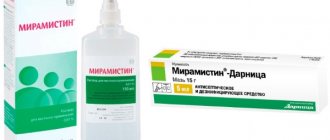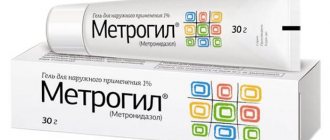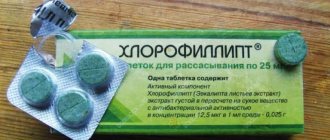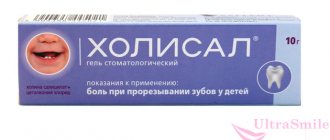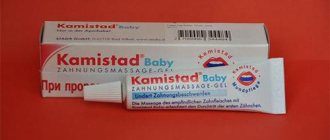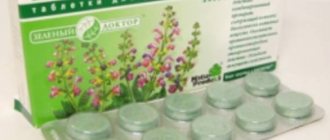pharmachologic effect
The ointment has an antimicrobial effect in soft tissue infections and is active against hospital strains, including those sensitive to antibacterial drugs. The active component interacts with the lipid layer of pathogens, resulting in their rapid destruction.
The drug has pronounced bactericidal, antifungal, antiviral effects (active against complex viruses such as herpes, immunodeficiency, etc.), and acts on pathogens that are sexually transmitted.
The ointment prevents the development of wound infections at sites of injury and burns, promotes tissue regeneration on the surface of the skin, and protects affected areas by activating various functions of phagocytes. It also stops the inflammatory process, absorbs purulent exudate, forms a dry scab, and does not have a negative effect on skin cells.
The drug strengthens local immunity and accelerates the healing process.
Pharmacokinetics
The drug is used topically, so it is not absorbed through the mucous membranes and skin.
The ointment prevents the development of wound infections at the sites of injuries and burns, promotes tissue regeneration on the surface of the skin.
Directions for use and doses
The drug should be used topically for adults.
Treatment of wounds and burns.
After standard treatment of wounds and burns, apply the drug directly to the affected surface, then apply a sterile gauze bandage or apply ointment to the dressing material and then to the wound.
You can also use tampons soaked in the drug, carefully filling the cavities of purulent wounds after surgical treatment, or gauze turundas with ointment, introducing them into the fistula tracts.
Use the drug once a day in the treatment of purulent wounds and burns in the 1st phase of the wound process and once every 1-3 days in the 2nd phase, depending on the condition of the wound. The dose depends on the area of the wound surface and the degree of purulent exudation. The duration of treatment is determined by the dynamics of wound cleansing and healing. If the infection is deeply localized in the soft tissues, it is possible to use the drug in conjunction with systemic antibiotics, and the duration of treatment will be determined by the duration of the antibiotic course.
Treatment of dermatological diseases.
Apply the drug in a thin layer to damaged areas of the skin or apply ointment to the dressing material, and then to the lesion 1-2 times a day. Duration of treatment - use the drug until negative results of microbiological control are obtained. For common dermatomycosis, in particular rubromycosis, the ointment can be used for 5-6 weeks in complex therapy with griseofulvin or systemic antifungal drugs. For fungal nail infections, the nail plates should be peeled off before starting treatment.
What is Miramistin ointment used for?
Ointment (cream) is used to treat the skin for various diseases. In surgical practice, it is used as a healing agent, since the drug promotes rapid tissue regeneration and does not affect healthy cells. It is also used to prevent possible bacterial complications. The ointment can be used as one of the necessary means during surgery.
The drug is recommended for skin diseases such as candidomycosis, pyoderma, onychomycosis, keratomycosis, dermatomycosis.
The ointment is effective for treating burns of various degrees and frostbite. When minor injuries occur at home or at work, the drug is used to prevent complications that may arise due to infection.
In addition, the product is indicated for periodontitis, stomatitis, sinusitis, laryngitis, acute and chronic otitis media and for the hygienic treatment of dentures. In urology, the drug is used as part of a complex treatment of acute or chronic inflammation of the prostate or urethra. For thrush, ointment is not recommended.
The drug can be used after sexual intercourse to prevent the development of sexually transmitted infections.
Solution dosage
For adults
Application in traumatology, combustiology, surgery for preventive and therapeutic purposes: irrigate the surface of burns, wounds, pack fistulas and wounds (not tightly), fix sterile tampons soaked in solution. The frequency of procedures is 2-3 times per day, about 3-5 days in a row. For drainage of cavities and wounds, the daily consumption of the drug is 1000 ml.
Use in gynecology, obstetrics for the prevention of infection in the postpartum period: irrigate the vagina 5-7 days before delivery, during childbirth after each vaginal examination and in the postpartum period: 50 ml per 1 tampon, exposure 2 hours, 5 days in a row.
When delivering by cesarean section, the vagina is treated before surgery. During the intervention, the uterine cavity and incision are treated. After the operation, tampons soaked in Miramistin are inserted into the vagina for 2 hours for 7 days.
Treatment of diseases of an inflammatory nature is carried out over a course of 2 weeks. Vaginal tampons and medicinal electrophoresis are used.
To prevent sexually transmitted infections, Miramistin must be used no later than 2 hours after sexual intercourse. The contents of the bottle are carefully introduced into the urethra with an exposure of 2-3 minutes: men 2-3 ml, women 1-2 ml + 5-10 ml into the vagina. After administering the solution, it is advisable not to urinate for 2 hours. Before the procedure, it is necessary to carry out hygiene of the external genitalia, and also treat the skin of the inner surfaces of the thighs, pubic area and genitals with Miramistin.
Complex therapy of urethritis and urethroprostatitis: 2-3 ml of the drug is injected into the urethra 1-2 times a day. Course 10 days.
Application in otolaryngology. When treating purulent sinusitis during puncture of the maxillary sinus, rinse the cavity with a sufficient amount of the drug (to clean water).
For the throat: treatment of tonsillitis, laryngitis and pharyngitis. Rinse or irrigate using a special spray nozzle: 2-3 presses per 1 procedure (approximately 10-15 ml), 3-4 times a day.
Application in dentistry - treatment of periodontitis, gingivitis, stomatitis. Rinse the mouth with the drug in an amount of 10-15 ml 3-4 times a day.
For children
For the treatment of acute pharyngitis or exacerbation of chronic tonsillitis - irrigation of the pharynx using a spray nozzle:
- children 3-6 years old: single press with a frequency of 3-4 times a day (3-5 ml per procedure);
- children 7-14 years old: double pressing with a frequency of 3-4 times a day (5-7 ml per procedure);
- children over 14 years old: press three or four times 3-4 times a day (10-15 ml per procedure).
Duration of use is from 4 to 10 days.
How to use Miramistin ointment
The ointment must be applied in a thin layer directly to the affected area after standard treatment. Then a gauze bandage should be applied to the wounds or burns. If fistulas are present, it is recommended to make gauze turundas with medication.
To treat wounds with pus or burn lesions, in the initial stage it is necessary to use the product once a day, and then switch to using it once every 2-3 days, depending on the severity of the symptoms.
The duration of the treatment process is determined by how quickly the affected areas heal and how actively the pus is cleared. In cases where the infectious process is concentrated in soft tissues, the ointment is prescribed simultaneously with taking antibacterial drugs.
To treat dermatological pathologies, the medicine is applied to the affected areas of the skin. When treating dermatomycosis, the drug is recommended to be used together with antifungal antibiotics, for example with Griseofulvin.
The recommended daily dose should not exceed 100 g. Before application, you should read the instructions for use.
The ointment must be applied in a thin layer directly to the affected area after standard treatment.
For diabetes
If there is a lack of insulin, the patient's blood flow may be impaired and the sensitivity of the nerve endings may decrease. The result of this is the appearance of diabetic foot syndrome, which is characterized by trophic ulcers on the feet. In this case, it is recommended to use disinfectants, which include this ointment. It acts gently, is not absorbed into tissues in damaged areas and does not interfere with the flow of oxygen.
Miramistin ointment: instructions for use
Depending on the area of application, the age of the patient and his clinical picture, the ointment is prescribed individually by the doctor.
- In surgery, the ointment is applied to the wounded surface. Only after surgical treatment of the wound. After which a sterile gauze bandage is applied to it. To achieve a greater effect, the medicine is applied to the dressing material, and then to the wound.
- In addition, if the wound is purulent, the drug is applied to a tampon. Then it is placed into the wound cavity after surgical treatment. Gauze compresses with the drug are also administered externally.
- If the drug was prescribed for the treatment of a purulent wound or burn that is in the active phase, then the drug can be used only once a day. After eliminating the inflammatory process, it can be used once every three days. Further treatment with the drug will depend on cleansing the wound and the recovery period. For deep wounds and cuts, the ointment can be used along with antibiotics.
- Bacterial and fungal infections are eliminated by applying the product several times a day to the affected area of the body. In some cases, special gauze bandages are made and applied to the damaged area of skin. Such procedures are divided once a day, but only if bacteriological tests are obtained.
- Extensive fungal infections are treated with miramistin in combination with systemic antifungal drugs. As a rule, lamisil and griseofulvin can be prescribed along with the dosage form. The recovery course will be at least five weeks.
- When treating infections and fungal infections of the nails, the medicine is applied in a thin layer to the peeling nail plates. Therapeutic rubbing is used until the plates are completely restored.
Use of Miramistin ointment for various diseases
Quite often, a solution is used along with the ointment. It is used in traumatology, combustiology, and surgery. The solution can be used for prophylaxis or complex therapy. It is used to irrigate the surface of burns and wounds.
With the help of packing fistulas are eliminated , and bandages are applied to wounds. Carry out the procedure no more than twice a day. The procedure is carried out over five days.
Miramistin is also used as drainage. In a number of preventative measures for postpartum infections, doctors irrigate the vagina for five days. As a rule, tampons are prescribed after each examination by a doctor.
In some cases , in gynecology it is possible to treat the vagina before surgery. Such cases include caesarean section. After the operation, the woman is given tampons for two hours. Anti-inflammatory therapy is carried out for seven days.
Many gynecologists advise patients to treat the vagina after sexual intercourse . In this way, a woman can protect herself from contracting a sexually transmitted disease. The same can be said about men, who can also treat their genitals with Miramistin. Before carrying out the procedure, you need to wash yourself thoroughly with soapy water.
for complex therapy of urethritis . The product is applied once a day for ten days. In the treatment of purulent sinusitis, as well as during puncture of the maxillary sinus, Miramistin is prescribed. The surface of the sinuses is carefully treated with a swab containing the drug.
In the treatment of purulent and infectious diseases of the throat, Miramistin spray is most often used. As a rule, it is prescribed up to three times a day. In some cases, the purulent surface of the throat mucosa is treated with cream.
In dentistry, doctors use Miramistin as an effective treatment for stomatitis or gingivitis. Prescribed up to three times a day. For children over the age of six, for sore throats, only sprays are prescribed, which are used up to three times a day.
Children from seven to fourteen years old can be prescribed ointments. Children over fourteen days old can use any form of the drug. It is allowed to treat the oral mucosa up to four times a day. The duration of taking the medicine is determined by the doctor. But as a rule, the course does not exceed ten days.
Side effects of Miramistin ointment
In some cases, when applying the drug to burns and trophic ulcers, a slight burning sensation may be felt, redness and itching may appear. These symptoms pass quickly, but do not be alarmed and stop the treatment process.
In rare cases, allergic manifestations on the skin are possible.
In rare cases, allergic manifestations on the skin occur from the use of the drug.
How to rinse your mouth properly after tooth extraction?
Rinsing your mouth after tooth extraction is strictly prohibited!
Instead they do:
- compresses based on a cotton swab;
- lotions on the gums (in addition to Miramistin, you can also use a decoction of chamomile);
- baths (just put the solution in your mouth and keep it there for a while).
Miramistin is diluted in boiled water cooled to room temperature at the rate of 15 milliliters of solution per 15-20 milliliters of water. If the doctor has prescribed compresses, then it is better to make them from sterile cotton wool, which is covered with several layers of ironed gauze on top. All this is thoroughly moistened in Miramistin solution and applied to the wound. It should be removed after 2-4 minutes. Over the next 60-90 minutes you should refrain from eating and drinking. There is no need to rinse your mouth after the compress. Do it 3-4 times a day.
Lotions on the gums with Miramistin are made if inflammation occurs due to an extracted tooth, affecting adjacent teeth.
Lotions should be made on the basis of cotton tape 3-4 millimeters wide.
It is moistened in Miramistin solution (prepared according to the above scheme) and placed on the inflamed part of the gums.
This compress should be kept for 4-5 minutes, after which the cotton tape should be removed. Do it 1-2 times a day.
Baths should be done only from the 3rd day after tooth extraction, not earlier. The solution itself is not diluted with water. Just put about 10-15 milliliters of it in your mouth and keep it there for 2-4 minutes. Then they spit. Perform the procedure 2-3 times a day.
It is also worth pointing out that if possible it is better not to do baths - there is a high risk of removing a blood clot from the wound.
As a rule, the doctor prescribes this procedure only in the following cases:
- a purulent abscess was opened;
- the patient has a high fever (caused by purulent inflammation);
- the patient has concomitant infectious diseases of the oral cavity (for example, stomatitis).
The permissible course of treatment is no more than 7 days. In the future, the use of Miramistin is stopped so as not to provoke an imbalance in the microflora of the oral cavity.
special instructions
When applying the ointment to the affected area, previously treated with an antiseptic solution, it will be much more effective. If there are purulent-necrotic masses in the wound, it is recommended to increase the dosage.
The drug does not have a negative effect on concentration, memory and reaction.
Prescription for children
In pediatric practice, the ointment is used in rare cases, since the drug is intended for the treatment of adult patients. Children under one year of age and older should use the product with caution under medical supervision.
The drug does not have a negative effect on concentration, memory and reaction.
During pregnancy and lactation
It is not recommended to use this drug at any stage of pregnancy and during the lactation period, although no reliable data have been found on the possible harm of the incoming components to the child.
Overdose
There are no cases of drug overdose, however, when treating a large area of skin, the active component can penetrate into the bloodstream, which will lead to prolonged bleeding. In this case, the dosage should be reduced or treatment with this drug should be completely discontinued.
When treating a large area of skin, the active ingredient may enter the bloodstream, resulting in prolonged bleeding.
Side effects
Occasionally, patients complain of a burning sensation at the sites where the drug was applied (especially in the form of an ointment). There is even slight redness on the skin and mild itching. These symptoms are not at all dangerous and do not require discontinuation of treatment. Everything returns to normal after a short time.
You should be aware that if too large areas of skin are treated, miramistin may partially penetrate the bloodstream, and this will cause excessive bleeding of wounds and ulcers. Then you can temporarily stop therapy with this drug or reduce its use.
You also need to know that soap solutions destroy the activity of miramistin.
Life does not guarantee a person absolute safety, so it is advisable to always keep this useful drug on hand and take it with you on the road.
Analogs
If it is necessary to treat damaged areas, the ointment can be replaced with the following preparations similar in composition and effect:
- Miramistin spray in a bottle with an applicator attachment or Chlorhexidine solution with a sprayer;
- Okomistin;
- Decamethoxin;
- methyluracil ointment.
Liquid products are convenient to use for gargling. The drug should be replaced only in consultation with a specialist.
